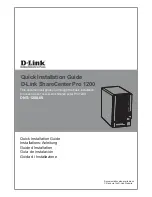
Chapter 25
| IP Interface Commands
IPv6 Interface
– 562 –
address errors
The number of input datagrams discarded because the IPv6 address in
their IPv6 header's destination field was not a valid address to be
received at this entity. This count includes invalid addresses (e.g., ::0)
and unsupported addresses (e.g., addresses with unallocated prefixes).
For entities which are not IPv6 routers and therefore do not forward
datagrams, this counter includes datagrams discarded because the
destination address was not a local address.
unknown protocols
The number of locally-addressed datagrams received successfully but
discarded because of an unknown or unsupported protocol. This
counter is incremented at the interface to which these datagrams were
addressed which might not be necessarily the input interface for some
of the datagrams.
truncated packets
The number of input datagrams discarded because datagram frame
didn't carry enough data.
discards
The number of input IPv6 datagrams for which no problems were
encountered to prevent their continued processing, but which were
discarded (e.g., for lack of buffer space). Note that this counter does not
include any datagrams discarded while awaiting re-assembly.
delivers
The total number of datagrams successfully delivered to IPv6 user-
protocols (including ICMP). This counter is incremented at the interface
to which these datagrams were addressed which might not be
necessarily the input interface for some of the datagrams.
reassembly request
datagrams
The number of IPv6 fragments received which needed to be
reassembled at this interface. Note that this counter is incremented at
the interface to which these fragments were addressed which might
not be necessarily the input interface for some of the fragments.
reassembly succeeded
The number of IPv6 datagrams successfully reassembled. Note that this
counter is incremented at the interface to which these datagrams were
addressed which might not be necessarily the input interface for some
of the fragments.
reassembly failed
The number of failures detected by the IPv6 re-assembly algorithm (for
whatever reason: timed out, errors, etc.). Note that this is not necessarily
a count of discarded IPv6 fragments since some algorithms (notably
the algorithm in RFC 815) can lose track of the number of fragments by
combining them as they are received. This counter is incremented at
the interface to which these fragments were addressed which might
not be necessarily the input interface for some of the fragments.
IPv6 sent
forwards datagrams
The number of output datagrams which this entity received and
forwarded to their final destinations. In entities which do not act as IPv6
routers, this counter will include only those packets which were Source-
Routed via this entity, and the Source-Route processing was successful.
Note that for a successfully forwarded datagram the counter of the
outgoing interface is incremented.
requests
The total number of IPv6 datagrams which local IPv6 user-protocols
(including ICMP) supplied to IPv6 in requests for transmission. Note
that this counter does not include any datagrams counted in
ipv6IfStatsOutForwDatagrams.
discards
The number of output IPv6 datagrams for which no problem was
encountered to prevent their transmission to their destination, but
which were discarded (e.g., for lack of buffer space). Note that this
counter would include datagrams counted in
ipv6IfStatsOutForwDatagrams if any such packets met this
(discretionary) discard criterion.
no routes
The number of input datagrams discarded because no route could be
found to transmit them to their destination.
Table 124: show ipv6 traffic - display description (Continued)
Field
Description
Summary of Contents for EX-3524
Page 2: ......
Page 28: ...Figures 28 ...
Page 34: ...Section I Getting Started 34 ...
Page 58: ...Chapter 1 Initial Switch Configuration Setting the System Clock 58 ...
Page 72: ...Chapter 2 Using the Command Line Interface CLI Command Groups 72 ...
Page 156: ...Chapter 5 SNMP Commands Notification Log Commands 156 ...
Page 164: ...Chapter 6 Remote Monitoring Commands 164 ...
Page 218: ...Chapter 7 Authentication Commands Management IP Filter 218 ...
Page 268: ...Chapter 8 General Security Measures Port based Traffic Segmentation 268 ...
Page 292: ...Chapter 9 Access Control Lists ACL Information 292 ...
Page 312: ...Chapter 10 Interface Commands Power Savings 312 ...
Page 324: ...Chapter 11 Link Aggregation Commands Trunk Status Display Commands 324 ...
Page 366: ...Chapter 15 Address Table Commands 366 ...
Page 428: ...Chapter 17 VLAN Commands Configuring Voice VLANs 428 ...
Page 572: ...Chapter 25 IP Interface Commands IPv6 Interface 572 ...
Page 578: ...Section I Appendices 578 ...
















































